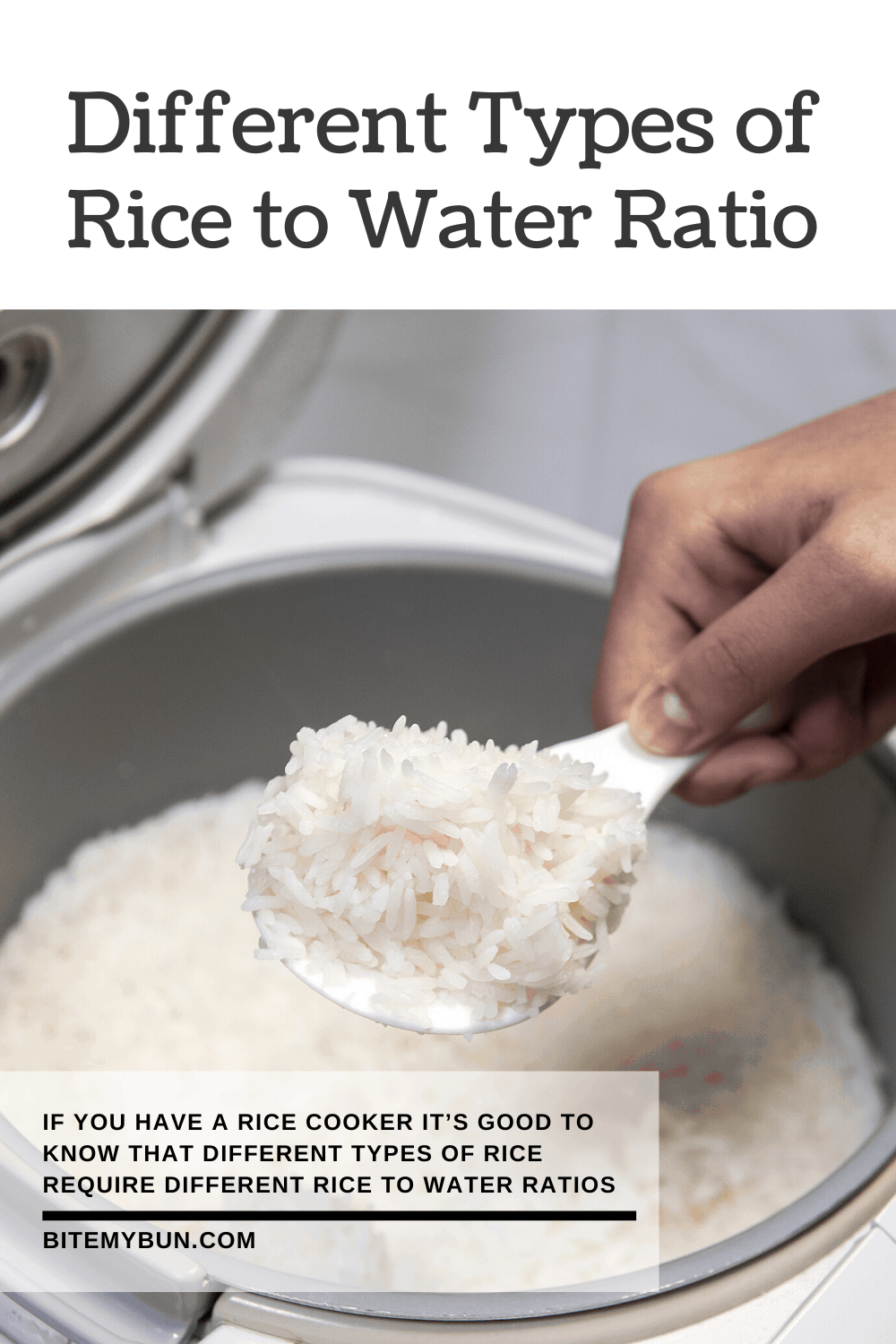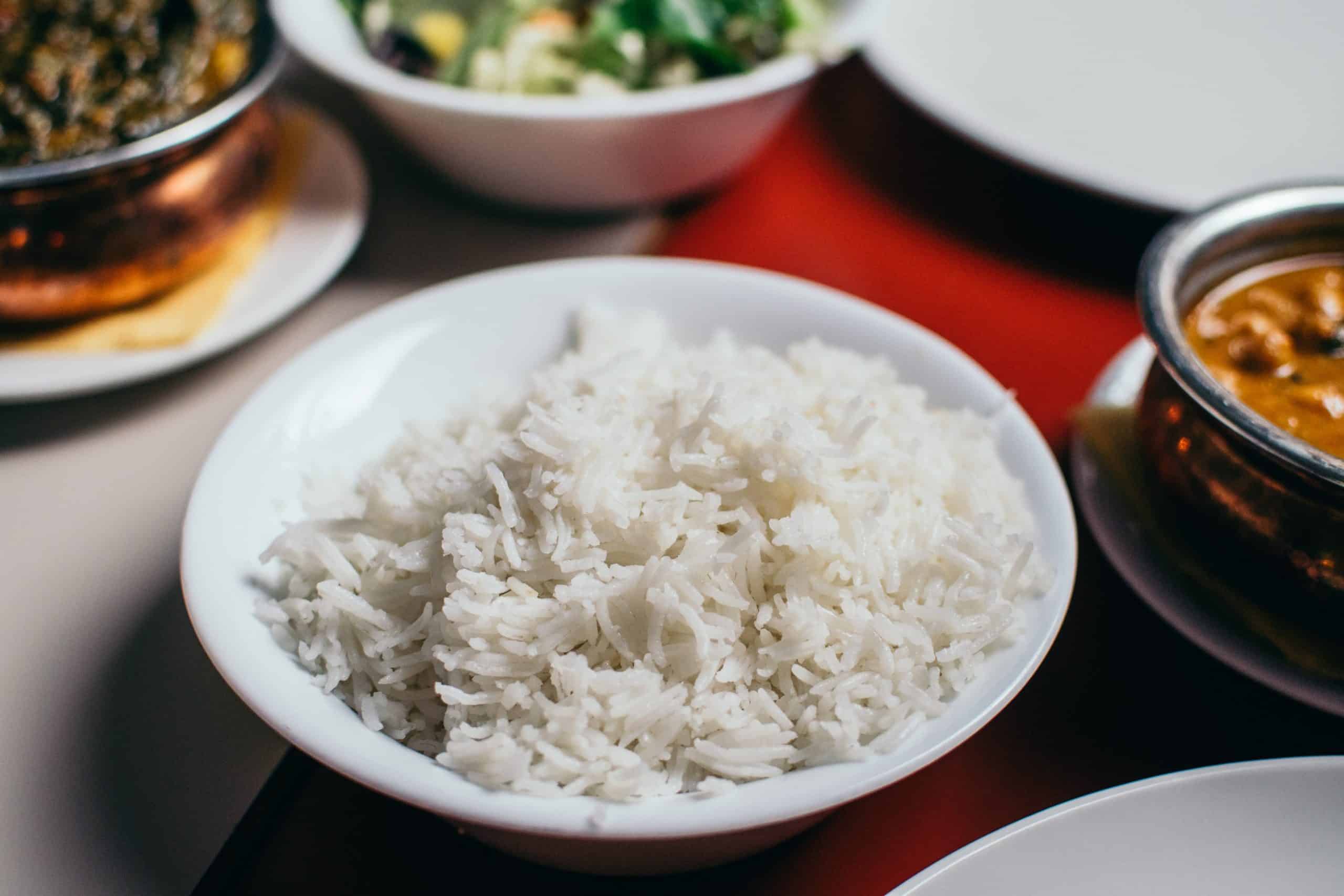Rice to water ratio in a rice cooker | White, jasmine, basmati
A good helping of rice is capable of transforming a modest vegetable dinner into a magnificent festival.
What’s great is, rice is easy to come by and not that expensive. Plus, it’s the ideal canvas for many dishes like stir-fried rice and butter chicken, among many others!
If you cook rice (and other grains) regularly and have the space to store it, it’s worth it. You don’t need any special equipment or ingredients to cook a pot of amazingly simple, tender, and fluffy rice.

If you have a rice cooker, it’s good to know that different types of rice require different rice to water ratios, which I’ll talk about in this post.
The correct rice to water ratio for your rice cooker should be 1:1, so that’s 1 cup of water for every cup of rice you want to cook. This holds true for most rice types and cookers, except basmati rice, which can be a bit trickier.

Check out our new cookbook
Bitemybun's family recipes with complete meal planner and recipe guide.
Try it out for free with Kindle Unlimited:
Read for freeIn this post we'll cover:
Water ratio for white rice
For most rice cookers, the instructions I have here are very general and standard. Even so, before you start, it’s good to dig your manual out and double-check the instructions.
Many rice cookers use the ratio of a cup of rice to a cup of water. When cooking large batches, just use the same ratio to scale up.
Smaller amounts are also possible, but the water won’t absorb at the same speed, so you may need to experiment to find out what works best with your rice cooker. It might be a little less water to rice in very small portions.
Start by rinsing the rice under running water before it’s moved to the rice cooker. This will wash away excess starch and render the rice less sticky.
Second, let the rice rest with the lid on for at least 10 minutes after cooking, and before serving. This resting time allows the last of the steam to cook off and it makes the rice fluffier with distinct grains.
And now on to our instructions. For white rice, use 1 cup of water per cup of rice, and make sure to add ½ tsp of salt per cup if you wish.
Also read: these are the best rice cookers you can buy
Steps:
- Place the rice in a large strainer or colander and thoroughly rinse it under cool water. At first, the water running through the rice appears milky, but then becomes clearer. It’s good if the water still has a touch of cloudiness. Before cooking rice, there’s no need to dry it; a little moisture on the rice is perfect.
- In the rice cooker, combine the rice and water. Add the salt. If you’ve skipped the rice rinsing step, now add a few extra tablespoons of water.
- Cook the rice by turning on the rice cooker and selecting the right option, according to your rice cooker (check the manual). The rice cooker automatically cooks the rice and turns off when it’s done. Check the estimated cooking times in your manual.
- Let the rice rest for 10 to 15 minutes in the slow cooker after the rice is cooked and the rice cooker shuts off. Keep the lid on while the rice is sitting. This helps prevent excessive stickiness or mushiness of the rice. You can also keep the rice in the cooker (for up to 30 minutes or so) until it’s ready to serve.
- Use a wooden spatula to fluff the rice into the rice cooker, then serve straight from the rice cooker or move the rice into a serving bowl. Serve as hot as possible.
Water ratio for jasmine rice
Often called Thai fragrant rice (Khao hom Mali), jasmine rice is considered long-grain rice and after being cooked, it’s only slightly sticky.
Why is it called jasmine rice? Because of its jasmine-like scent and its white appearance like that of the jasmine flower.
This type of rice is mainly cultivated in Thailand. In Southeast Asia, jasmine rice is consumed a lot.
Mom often said that jasmine rice costs more than Indonesia’s long-grain white rice, which is grown locally.
Jasmine rice storage
If properly stored, jasmine rice or almost any white rice can be stored almost indefinitely. Jasmine rice, however, will lose its fragrance over time.
Here’s what you can do to prolong its shelf life and maintain that amazing aroma of jasmine rice.
Avoid buying a bag that’s too big. I know it’s more cost-effective, but if you don’t eat it often, the jasmine rice will lose its delightful fragrance. It’s not a big deal if you don’t care much about it since it’s still edible.
For the best conditions, make sure it’s stored in a cool and dry area. Regardless, using an airtight container is a must. You can leave it as is if the rice comes in a resealable bag. If not, I usually transfer it to a container that’s airtight.
Also read: these are the best sauces to use for rice
Preparation
Whether you’re going to cook jasmine rice in a rice cooker, in an instant pot, on the burner, or in the microwave, the steps to prepare jasmine rice are the same:
- Rinse the rice. The rice must be rinsed in several water changes until the water is clear. This is important! If you don’t do this, the rice will become more “sticky.”
- Jasmine rice should never be soaked before cooking. So after you rinse the rice, make sure you drain the water immediately and don’t let the rice sit and soak, as it’ll interfere with our water to rice ratio later on.
- To drain the water completely, use a large stainless steel strainer. The use of a strainer is very useful to ensure that no more water accumulatesbetween the grains, as this will affect the end result and your rice will be too soft and mushy.
How to cook jasmine rice using a rice cooker
- Place the rice in the inner pot of the rice cooker after washing and draining the water.
- If you cook rice in a rice cooker, as opposed to cooking the rice on the burner, very little water is lost during the cooking process. This is why the water to rice ratio for the rice cooker is 1:1 water to jasmine rice. So for 1 cup of rice, use 1 cup of water, and similarly, for 3 cups of rice, you’ll use 3 cups of water. Just remember that you have to use the same cup to measure both the rice and water. Don’t use different cups since the measurements will be different.
- Many rice cookers have multiple settings. I set mine to “white” rice when cooking jasmine rice as well. It usually takes around 20 minutes to cook.
- Once it’s done cooking, wait 10 minutes before opening the lid so the rice finishes absorbing the water. If you open the lid too soon, it might feel a little softer and wetter.
- The final step is to fluff the rice after it’s done cooking. Why do we do this? This separates the rice grains so it doesn’t end up being all mushy; it gives you fluffy rice. Most rice cookers come with a paddle for this, but you can also use a fork. Just be careful not to scratch the inside of the pot.
Water ratio for basmati rice

Basmati rice is thin, long-grain rice commonly used in India, Central Asia, and the Middle East. Basmati rice has a strong nutty flavor and its name means “fragrant.”
India produces most of the basmati rice supply worldwide. And most of the basmati rice imported into the U.S. has been aged for a minimum of 6 months in order to intensify its nutty aroma. It’s also common to see locally produced basmati rice from Northern California.
What I love most about cooked rice (besides its taste) is that the grains can get incredibly long, about 3/4 inches in length. You need to soak the rice first and use the same water to cook the rice to get this distinct shape. Before I got it right, I had multiple failed attempts! Here are some tips on cooking basmati rice perfectly so you can get it right quicker than I did.
Wash the rice
Rinsing the rice removes excess starch and helps to keep the rice from clumping once it’s been cooked. The water will look milky when you first wash the rice. Drain and wash the rice 4 more times with fresh water. The water will eventually look pretty clear.
For basmati rice, things get a little more complex. We’ve had our share of experiences and with one cooker, it’s less water per rice so ¾ water to 1 cup rice, while on the other one, it’s 1 ¼ water per cup of rice, so it might be trickier to get it just right on the first try.
Recommended rice cookers
You might not always get the water to rice ratio perfectly correct. So in those cases, it’s good to know that you can rely on your rice cooker. That’s why I recommend the Zojirushi Neuro Fuzzy NS-ZCC10 rice cooker.
This rice cooker makes Japanese rice beautifully and is good for other varieties, even if you mess up the proportions. Even though it’s a bit slow, it’s the most outstanding and foolproof cooker I’ve ever tried.
If you’re looking for an amazing pick that’s closer to your budget, we recommend the Hamilton Beach Rice and Hot Cereal Cooker. This simple model is the fastest non-pressure cooker (some pressure cookers were faster) we’ve tested, making Japanese rice in about 35 minutes. The rice isn’t as perfect as our first choice, but it’s a great option on a budget for college students or anyone who wants quick cooked rice.
Get the rice to water ratio for a rice cooker right
The next time you go to cook some rice, you’ll know exactly how much water you need to cook that perfect bowl of rice in a rice cooker. While some rice is trickier than others, with enough time and tries, you’ll be a rice cooking pro! You’ll be chowing down on fluffy rice in no time.
Also read: this is the right way to make sushi vinegar for your rice
Check out our new cookbook
Bitemybun's family recipes with complete meal planner and recipe guide.
Try it out for free with Kindle Unlimited:
Read for freeJoost Nusselder, the founder of Bite My Bun is a content marketer, dad and loves trying out new food with Japanese food at the heart of his passion, and together with his team he's been creating in-depth blog articles since 2016 to help loyal readers with recipes and cooking tips.
